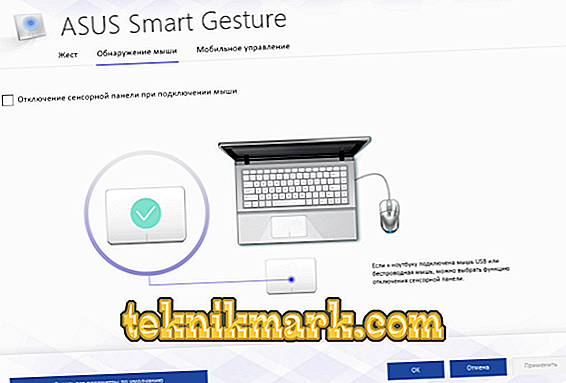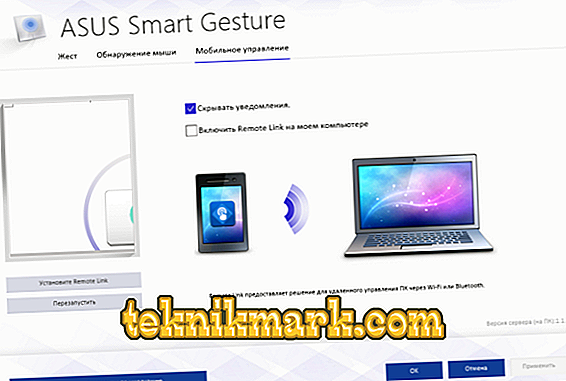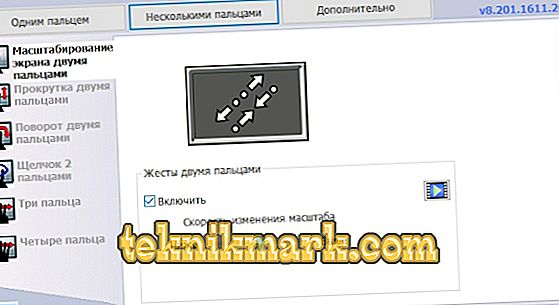Each user of a laptop / netbook is familiar with an input device called a touchpad. For some users, this is the most convenient replacement for familiar computer mice, as it opens up a lot of functionality, for others, especially gamers, this is a terrible device that is often used randomly than intentionally. But few people know that laptop developers have long foreseen most of the possible nuances when working with the touchpad and provided users with the ability to enable or disable the touchpad, as well as set their own settings and create personal gestures that make it as easy as possible to use this device. As the title of this article shows, the discussion will focus on the existing features of the touch panel settings for devices on the Windows 10 operating system.

How to work with touchpad gestures in Windows 10.
Enable and disable
Manufacturers of mobile personal computers maximally simplify the order of switching on / off the sensor model. Some modern laptops (HP) have a dedicated button next to the touchpad, which is responsible for its activation and deactivation. Accordingly, all that remains is to click on this button and get the desired result. But this possibility is not realized on all laptops. In most cases, a combination of the “Fn” and “F1 - F12” keys is responsible for enabling / disabling. It all depends on the manufacturer of the selected device, for example:
- "Asus" - a combination of "Fn + F9";
- "Lenovo" - "Fn + F8";
- "Samsung" - "Fn + F5";
- Toshiba - Fn + F5;
- "Acer" - "Fn + F7";
- “Dell” - “Fn + F5”.

Unfortunately, there are cases when the key combinations mentioned above simply do not work. In this case, you should pay attention to the BIOS settings, and for this you will need to do the following:
- When you turn on the computer, also depending on the manufacturer, open the BIOS settings. This can be the “F2”, “Delete”, “TAB” key, etc .;
- on the “Advanced” tab, find the parameter that has the “Pointing Device” in the name, and put it in the “Enabled” mode to turn it on, and “Disabled” to turn it off;
- save the changed configuration by pressing the “F10” key and wait for the computer to restart.
In the event that none of the above has helped, it is possible that incorrect drivers of this software affect the correct operation of the touchpad. Therefore, you will need to install or reinstall them in any convenient way, for example, by downloading from the manufacturer’s website or using the specialized software - “DriverPack Solution”.
Customization
Now we should touch on the most interesting question related to the creation of our own “hot gestures” and other settings of the touch panel. To do this, on a computer with Windows 10 operating system, you will need to do the following:
- click on the “Start” button and select the “Settings” section and then the “Devices”;

- on the right side of the window that opens, go to the “Touch Panel” subsection;
- In the same section, you can adjust the sensitivity of the touchpad and open additional settings of the device;

- Further, it is impossible to give a specific procedure, as the next steps depend on the opportunities provided by the developers to change the functionality of the touchpad.
Asus
For example, for laptops "Asus" there is a special utility called "Asus Smart Gesture", the label from which is placed in the tray. It should be noted that this utility completely replaces the previously used drivers, therefore, in the “Properties” section of the “ELAN” tab (depending on the manufacturer, the name may be different), the devices will not be displayed, but in this case it is not required. The utility management window consists of three tabs:
- “Gestures” tab, where you can turn on or turn off certain parameters for which one / two or three / four fingers control is responsible;

- The Mouse Detection tab allows you to activate the mode in which the touch panel is turned off immediately after connecting the computer mouse;

- tab "Mobile Management", with which you can enable remote control of a computer using the technology "Remote Link".

As you can see, the company “Asus” does not provide much personalization opportunities, these are only basic parameters, similar to the mouse settings.
Lenovo
According to a similar scheme, sometimes with a large range of customizable parameters, there are other manufacturers. For example, the company "Lenovo" also highlights a separate utility with which you can configure the following points:
- The “One Finger” tab provides, respectively, the ability to activate or deactivate the standard touchpad control functions using one finger, for example, clicking or dragging an object.

- The Multi Fingers tab includes the most customizable options: scaling or a menu call. In addition to enabling / disabling such control, you can change additional indicators of several functions, for example, using the slider you can adjust the zoom speed to the most comfortable indicator, as well as quickly review the changes made.

- The tab "Advanced" includes three subsections:
- "Tracing the palm." It is not uncommon for the touchpad to recognize the touch of the palm for trying to execute a command, which leads to completely different results than expected. Using this parameter, you can configure the touchpad response to a random touch of the sensors with your palm.
- "Sensitivity of the sensor." The name of the subsection speaks for itself.
- "Movement over the edge." It is necessary to get used to the control of the device in question, since it is not always possible to immediately use the control with a few fingers. For example, when changing the scale, fingers often go beyond the sensor boundary, and to achieve the desired scale, you have to repeat the manipulations again. This subsection will help minimize the risk of recurrence of a similar situation.

In addition, to get more detailed information on the use of custom parameters, just click on the icon with a "?", Which is located in the lower left corner of the window. Information provided in excess and with step-by-step illustrations.
Conclusion
In conclusion, it is worth noting that, despite the dual attitudes of users towards the device considered in this article, it is necessary to note its exceptional usefulness. With certain skills in owning a touchpad, you can see that the usual mouse is functionally no worse, and in some moments even more convenient. Therefore, you should not rush to turn it off.








